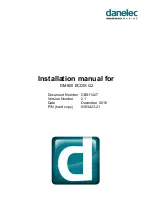
GE Healthcare
Senographe DS Acquisition System
Revision 1
Operator Manual 5307907-3-S-1EN
Image Acquisition Procedure
12-imgac.fm
Page no. 133
Chapter 12
8
Thickness display
The thickness of the compressed breast is used in determining the average glandular dose (AGD), and
for AOP calculations. It appears on the Gantry readout, and can be displayed on the image as an anno-
tation (see Chapter
).
•
If a valid compression paddle is detected, the actual compression thickness is displayed, whatever
the compression force (even if it is lower than the minimum force required for AOP).
•
If no compression paddle is mounted or if a non valid compression paddle is detected, the compres-
sion thickness display remains blank.
•
The compression thickness taken into account by the system for exposure parameters and displayed
on the image is the value shown on the Gantry readout when the Operator presses the Prep button
on the X-ray Console.
Note:
When making an image with no compression, or using a compression force less than the minimum
force required for AOP, the compressed breast thickness displayed on the image and recorded in
the image file is 45 mm. The ESE and AGD are then computed assuming a breast thickness of
45 mm, except in the case of extreme thicknesses for which the AGD computation cannot be done,
which result in a displayed AGD of 0. An extreme thickness is a compressed breast thickness ei-
ther less than approximately 20 mm or greater than approximately 80 mm.
9
Image acquisition
Note:
When Right/Left image pairs are acquired, it is recommended that the Right image should always
be acquired before the Left. This ensures consistent display when using the 2 x 1 view; when the
image acquired first is selected, the pair is displayed with the two chest walls in the center of the
screen.
•
The image acquisition function must be entered from the Worklist
function. Select the correct
patient in the
Worklist (a new patient can be created if necessary), and click the
Start Exam
button
in the Worklist window, to display the Viewer window and permit exposures.
•
When ready for the exam, check the image information displayed on the X-ray Console. It should
include:
-
The Support Arm angle, if other than 0°.
-
The magnification factor (e.g., M 1.5), if magnification is used.
•
Select the breast laterality (right or left). The Console should now show:
-
Laterality (R or L).
-
View name (e.g., LCC, RML, LLM, etc.).
•
Check the displayed view name. For special views or recumbent patients, modify the view name
manually:
-
Special Views for standing or sitting patients.
ual view name selection (standing or sitting patients) on page 41
-
View names for recumbent patients.
Refer to Chapter
for recumbent patients on page 41
FOR
TRAINING
PURPOSES
ONLY!
NOTE:
Once
downloaded,
this
document
is
UNCONTROLLED,
and
therefore
may
not
be
the
latest
revision.
Always
confirm
revision
status
against
a
validated
source
(ie
CDL).
















































